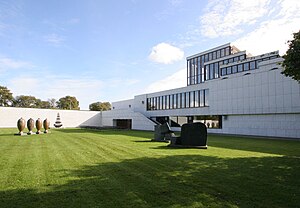KUNSTEN Museum of Modern Art Aalborg
| KUNSTEN | |

The museum and sculpture garden
|
|
| Established | 1972 |
|---|---|
| Location | Aalborg, Denmark |
| Coordinates | 57°2′34″N 9°54′21″E / 57.04278°N 9.90583°E |
| Collection size | 1500 items of collections of modern art |
| Visitors | 28.608 (2014) |
| Director | Gitte Ørskou |
| Website | http://kunsten.dk/ |
KUNSTEN Museum of Modern Art Aalborg is located in Aalborg, Denmark, on Kong Christians Allé near its junction with Vetserbro. Of a modern Scandinavian design, it was built between 1968-72 by Finnish architects Elissa and Alvar Aalto and Danish architect Jean-Jacques Baruël. It was completed on 8 June 1972.
The museum has been termed a "showplace for 20th-century Danish and international art", as it showcases both domestic and international modern art collections. It is described as "strikingly contemporary in both form and content".
The architectural plans for designing the museum were selected from the 144 submissions made to the Nordic architectural competition by 15 January 1958. The competition was won by the Finnish architects Alvar Aalto, his wife Elissa, and his associate Jean-Jacques Baruël. However, due to financial problems, actual construction only started in 1966. Completed in 1972, it was officially inaugurated on 8 June 1972. It received its present name in 2008, before that it was known as the North Jutland Art Museum in Aalborg (Danish: Nordjyllands Kunstmuseum i Aalborg).
The museum, rising against the hills like a ziggurat, extends over 6,000 m2 (65,000 sq ft). It is built to a square plan with galleries organised on the ground level around the central exhibition area. In addition to the entrance hall and offices, the building consists of a sculpture gallery, several sky-lit galleries and seven small display rooms. The roof is set above the central hall which rises in the form of a pyramid, providing a skylight in the form of a crown-shaped lantern. Both sides of the central hall have lobbies or galleries which are well lit by natural light while the rear can be divided into smaller rooms by means of flexible walls.
The combination of strategically placed skylights and diffused lighting has effectively "manipulated the Nordic light" in illuminating the galleries, relying on a series of reflectors and light-coloured materials. The "two-sided, elongated skylights" control the sunlight on the southern side to a restricted angle of 56 degrees whereas it is fully open at a 90-degree angle on its northern side. The ceiling has suspended lights with double parabolic reflecting surfaces, avoiding any shadows. The music room in the main building is fitted with prism-shaped skylights. The light, as it gets deflected from the screens, walls and boards induces diffused lighting of the open spaces of the museum, gaining the name of a "light machine". The quality of the light adapts to the needs of day and night.
...
Wikipedia

